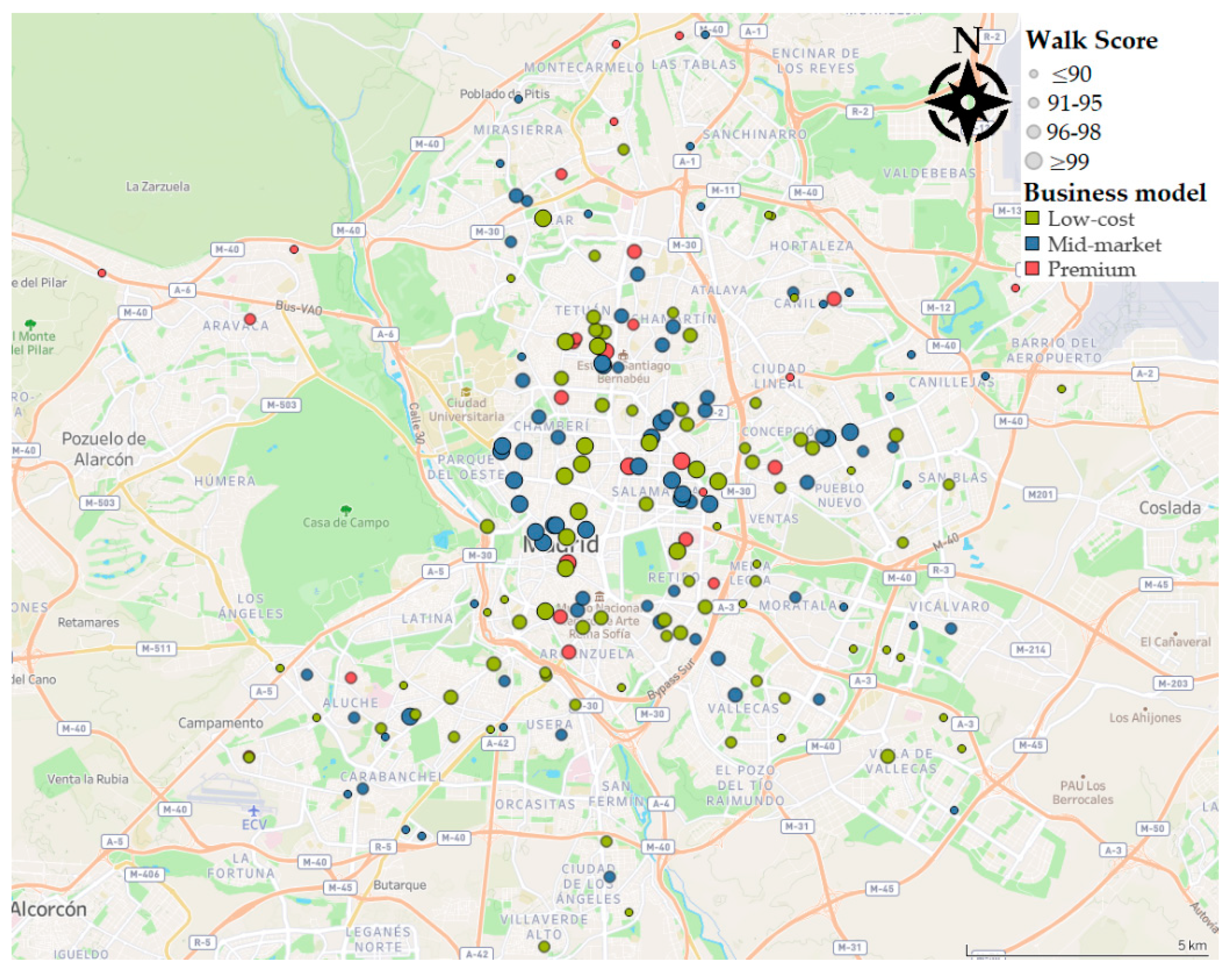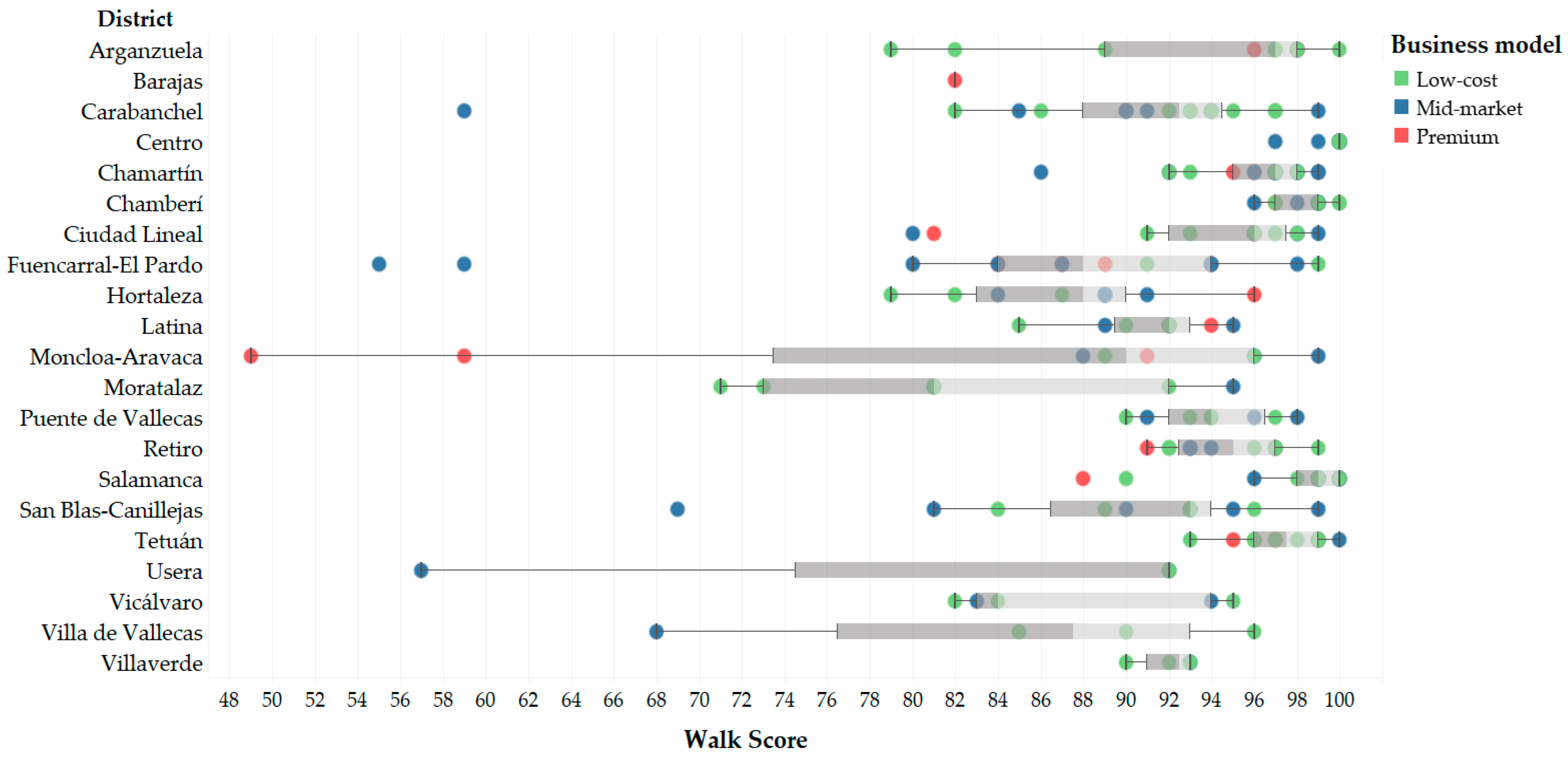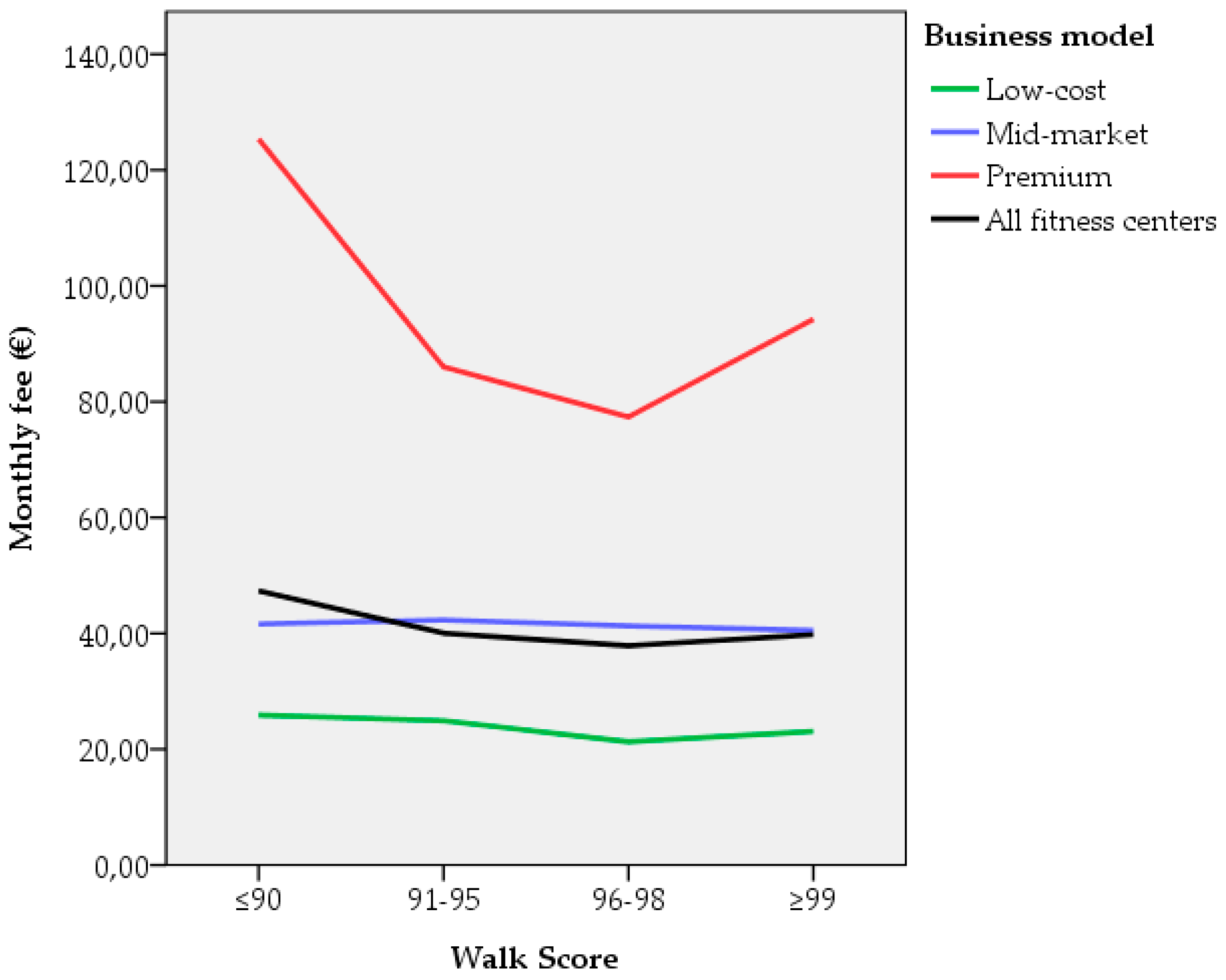Walkability and Fitness Center Prices, Opening Hours, and Extra Services: The Case of Madrid, Spain
Abstract
1. Introduction
2. Materials and Methods
3. Results
3.1. Descriptive Statistics
3.2. Association Between Walk Score® and the Monthly Fee
3.3. Association Between Walk Score® and Opening Hours
3.4. Association Between Walk Score® and the Existence of a Swimming Pool
4. Discussion
5. Conclusions
Author Contributions
Funding
Conflicts of Interest
References
- Wang, H.; Yang, Y. Neighbourhood walkability: A review and bibliometric analysis. Cities 2019, 93, 43–61. [Google Scholar]
- Hall, C.M.; Ram, Y. Walk score® and its potential contribution to the study of active transport and walkability: A critical and systematic review. Transp. Res. Part D Transp. Environ. 2018, 61, 310–324. [Google Scholar] [CrossRef]
- Doyle, S.; Kelly-Schwartz, A.; Schlossberg, M.; Stockard, J. Active Community Environments and Health: The Relationship of Walkable and Safe Communities to Individual Health. J. Am. Plan. Assoc. 2006, 72, 19–31. [Google Scholar]
- Van Cauwenberg, J.; Van Holle, V.; De Bourdeaudhuij, I.; Van Dyck, D.; Deforche, B. Neighborhood walkability and health outcomes among older adults: The mediating role of physical activity. Heal. Place 2016, 37, 16–25. [Google Scholar]
- Southworth, M. Designing the Walkable City. J. Urban Plan. Dev. 2005, 131, 246–257. [Google Scholar] [CrossRef]
- Corti, B.; Wood, G.; Pikora, T.; Learnihan, V.; Bulsara, M.; Van Niel, K.; Timperio, A.; McCormack, G.; Villanueva, K. School site and the potential to walk to school: The impact of street connectivity and traffic exposure in school neighborhoods. Heal. Place 2011, 17, 545–550. [Google Scholar]
- Leinberger, C.B.; Alfonzo, M. Walk This Way: The Economic Promise of Walkable Places in Metropolitan Washington, D.C.; The Brookings Institution: Washington, DC, USA, 2012. [Google Scholar]
- Rafiemanzelat, R.; Emadi, M.I.; Kamali, A.J. City sustainability: The influence of walkability on built environments. Transp. Res. Procedia 2017, 24, 97–104. [Google Scholar]
- Lytras, M.D.; Visvizi, A. Who Uses Smart City Services and What to Make of It: Toward Interdisciplinary Smart Cities Research. Sustainability 2018, 10, 1998. [Google Scholar] [CrossRef]
- Yeh, H. The effects of successful ICT-based smart city services: From citizens’ perspectives. Gov. Inf. Q. 2017, 34, 556–565. [Google Scholar]
- O’Donoghue, G.; Perchoux, C.; Mensah, K.; Lakerveld, J.; van der Ploeg, H.; Bernaards, C.; Chastin, S.F.M.; Simon, C.; O’Gorman, D.; Nazare, J.A. A systematic review of correlates of sedentary behaviour in adults aged 18–65 years: A socio-ecological approach. BMC Public Health 2016, 16, 163. [Google Scholar]
- Rhodes, R.; Mark, R.S.; Temmel, C.P. Adult Sedentary Behavior. Am. J. Prev. Med. 2012, 42, e3–e28. [Google Scholar] [CrossRef] [PubMed]
- Forsyth, A. What is a walkable place? The walkability debate in urban design. Urban Des. Int. 2015, 20, 274–292. [Google Scholar] [CrossRef]
- Hall, C.M.; Ram, Y. Measuring the relationship between tourism and walkability? Walk Score and English tourist attractions. J. Sustain. Tour. 2018, 27, 223–240. [Google Scholar]
- Vale, D.; Saraiva, M.; Pereira, M. Active accessibility: A review of operational measures of walking and cycling accessibility. J. Transp. Land Use 2015, 9, 209–235. [Google Scholar]
- Fitzgerald, M.; Pasha, A. Google Ajax Search API; O’Reilly Media, Inc.: Sebastopol, CA, USA, 2007. [Google Scholar]
- Carr, L.J.; Dunsiger, S.I.; Marcus, B.H. Walk ScoreTM as a Global Estimate of Neighborhood Walkability. Am. J. Prev. Med. 2010, 39, 460–463. [Google Scholar] [CrossRef]
- Carr, L.; Dunsiger, S.I.; Marcus, B.H. Validation of Walk Score for estimating access to walkable amenities. Br. J. Sports Med. 2010, 45, 1144–1148. [Google Scholar] [CrossRef]
- Duncan, D.T.; Aldstadt, J.; Whalen, J.; Melly, S.J.; Gortmaker, S.L. Validation of Walk Score® for Estimating Neighborhood Walkability: An Analysis of Four US Metropolitan Areas. Int. J. Environ. Res. Public Heal. 2011, 8, 4160–4179. [Google Scholar] [CrossRef]
- Duncan, D.T.; Meline, J.; Kestens, Y.; Day, K.; Elbel, B.; Trasande, L.; Chaix, B. Walk Score, Transportation Mode Choice, and Walking Among French Adults: A GPS, Accelerometer, and Mobility Survey Study. Int. J. Environ. Res. Public Heal. 2016, 13, 611. [Google Scholar] [CrossRef]
- Meline, J.; Chaix, B.; Pannier, B.; Ogedegbe, G.; Trasande, L.; Athens, J.K.; Duncan, D.T. Neighborhood walk score and selected Cardiometabolic factors in the French RECORD cohort study. BMC Public Heal. 2017, 17, 960. [Google Scholar]
- Koohsari, M.J.; Sugiyama, T.; Hanibuchi, T.; Shibata, A.; Ishii, K.; Liao, Y.; Oka, K. Validity of Walk Score® as a measure of neighborhood walkability in Japan. Prev. Med. Rep. 2018, 9, 114–117. [Google Scholar] [CrossRef]
- Ram, Y.; Hall, C.M. Walk Score and tourist accommodation. Int. J. Tour. Cities 2018, 4, 369–375. [Google Scholar] [CrossRef]
- Simbaqueba, J. What Does Walk Score® Really Measure? Master’s Thesis, University of Connecticut, Mansfield, CT, USA, 2018. [Google Scholar]
- Lo, B.K.; Graham, M.L.; Folta, S.C.; Paul, L.C.; Strogatz, D.; Nelson, M.E.; Parry, S.; Carfagno, M.E.; Wing, D.; Higgins, M.; et al. Examining the Associations between Walk Score, Perceived Built Environment, and Physical Activity Behaviors among Women Participating in a Community-Randomized Lifestyle Change Intervention Trial: Strong Hearts, Healthy Communities. Int. J. Environ. Res. Public Heal. 2019, 16, 849. [Google Scholar] [CrossRef] [PubMed]
- Loo, C.K.J.; Greiver, M.; Aliarzadeh, B.; Lewis, D. Association between neighbourhood walkability and metabolic risk factors influenced by physical activity: A cross-sectional study of adults in Toronto, Canada. BMJ Open 2017, 7, e013889. [Google Scholar] [CrossRef] [PubMed]
- Orychock, K.; Fuller, D. Association between BMI and WalkScore, Dining and Drinking Score, Grocery Score and Transit Score in a multi-city sample of adults: A cross-sectional analysis. In Proceedings of the APHA’s 2019 Annual Meeting and Expo, Philadelphia, PA, USA, 2–6 November 2019. [Google Scholar]
- Howe, K.B.; Suharlim, C.; Ueda, P.; Howe, D.; Kawachi, I.; Rimm, E.B. Gotta catch’em all! Pokémon GO and physical activity among young adults: Difference in differences study. BMJ 2016, 355, i6270. [Google Scholar] [CrossRef] [PubMed]
- Cheung, R.; Woo, M. Determinants of Perceived Service Quality: An Empirical Investigation of Fitness and Recreational Facilities. Contemp. Manag. Res. 2016, 12, 363–370. [Google Scholar] [CrossRef][Green Version]
- Emeterio, I.C.S.; Garcia-Unanue, J.; Iglesias-Soler, E.; Felipe, J.; Gallardo, L. Prediction of abandonment in Spanish fitness centres. Eur. J. Sport Sci. 2018, 19, 217–224. [Google Scholar] [CrossRef]
- García-Fernández, J.; Gálvez-Ruiz, P.; Velez-Colon, L.; Bernal-Garcia, A. Service convenience, perceived value, satisfaction, and loyalty: A study of consumers from low-cost fitness centers in Spain. J. Phys. Educ. Sport 2016, 16, 1146–1152. [Google Scholar]
- León-Quismondo, J.; Garcia-Unanue, J.; Burillo, P. Best Practices for Fitness Center Business Sustainability: A Qualitative Vision. Sustainability 2020, 12, 5067. [Google Scholar] [CrossRef]
- Madrid Council’s Open Data Portal. Censo de locales, sus actividades y terrazas de hostelería y restauración. Available online: https://datos.madrid.es/sites/v/index.jsp?vgnextoid=66665cde99be2410VgnVCM1000000b205a0aRCRD&vgnextchannel=374512b9ace9f310VgnVCM100000171f5a0aRCRD (accessed on 11 May 2018).
- Walk Score®. Available online: https://www.walkscore.com/ (accessed on 20 May 2020).
- Li, W.; Joh, K.; Lee, C.; Kim, J.-H.; Park, H.; Woo, A. Assessing Benefits of Neighborhood Walkability to Single-Family Property Values. J. Plan. Educ. Res. 2015, 35, 471–488. [Google Scholar] [CrossRef]
- Trowbridge, M.J.; Pickell, S.G.; Pyke, C.R.; Jutte, D.P. Building Healthy Communities: Establishing Health And Wellness Metrics For Use Within The Real Estate Industry. Heal. Aff. 2014, 33, 1923–1929. [Google Scholar] [CrossRef]
- León-Quismondo, J.; García-Unanue, J.; Burillo, P. Priorities in the management of fitness centers. Application of Importance-Performance Analysis. J. Sports Econ. Manag. 2018, 8, 116–136. [Google Scholar]
- Heroux, L. Comparative Marketing Strategies of Fitness Clubs in the United States and Canada. Econ. World 2017, 5, 529–538. [Google Scholar]
- García-Fernández, J.; Gálvez-Ruíz, P.; Fernández-Gavira, J.; Vélez-Colón, L.; Pitts, B.; Bernal-García, A. The effects of service convenience and perceived quality on perceived value, satisfaction and loyalty in low-cost fitness centers. Sport Manag. Rev. 2018, 21, 250–262. [Google Scholar] [CrossRef]
- León-Quismondo, J.; Garcia-Unanue, J.; Burillo, P. Service Perceptions in Fitness Centers: IPA Approach by Gender and Age. Int. J. Environ. Res. Public Heal. 2020, 17, 2844. [Google Scholar] [CrossRef] [PubMed]
- García-Fernández, J.; Gálvez-Ruíz, P.; Fernández-Gavira, J.; Vélez-Colón, L. A loyalty model according to membership longevity of low-cost fitness center: Quality, value, satisfaction, and behavioral intention. Revista de Psicología del Deporte 2016, 25, 107–110. [Google Scholar]
- Afthinos, Y.; Theodorakis, N.D.; Nassis, P. Customers’ expectations of service in Greek fitness centers. Manag. Serv. Qual. Int. J. 2005, 15, 245–258. [Google Scholar] [CrossRef]
- Alexandris, K.; Zahariadis, P.; Tsorbatzoudis, C.; Grouios, G. An empirical investigation of the relationships among service quality, customer satisfaction and psychological commitment in a health club context. Eur. Sport Manag. Q. 2004, 4, 36–52. [Google Scholar] [CrossRef]
- Avourdiadou, S.; Theodorakis, N.D. The development of loyalty among novice and experienced customers of sport and fitness centres. Sport Manag. Rev. 2014, 17, 419–431. [Google Scholar] [CrossRef]
- MacIntosh, E.; Law, B. Should I stay or should I go? Exploring the decision to join, maintain, or cancel a fitness membership. Manag. Sport Leis. 2015, 20, 191–210. [Google Scholar] [CrossRef]
- Hall, C.M.; Ram, Y.; Shoval, N. The Routledge International Handbook of Walking; Routledge: London, UK, 2017; ISBN 9781315638461. [Google Scholar]
- Prado-Gascó, V.; Calabuig, F.; Crespo, J.; Nuñez-Pomar, J. Satisfaction of users of aquatic activities: Free swimming vs. guided activities. J. Phys. Educ. Sport 2018, 18, 1247–1434. [Google Scholar]




| Variable | All Cases (SD) | Low-Cost (n = 84) | Mid-Market (n = 82) | Premium (n = 27) |
|---|---|---|---|---|
| Walk Score® | 92.02 (9.02) | 92.71 (6.35) | 91.82 (10.26) | 90.44 (11.83) |
| Monthly fee (€) | 41.46 (28.70) | 23.88 (4.39) | 41.40 (7.47) | 96.33 (41.48) |
| Daily opening hours | 15.36 (3.16) | 15.20 (1.74) | 15.32 (3.88) | 15.97 (4.05) |
| Walk Score® | Average Monthly Fee (SD) | Difference | p-Value |
|---|---|---|---|
| ≤90 | 125.37 (48.74) | 47.99 | 0.032 |
| 96–98 | 77.38 (25.19) |
| Equation | Model Summary | Parameter Estimates | ||||||
|---|---|---|---|---|---|---|---|---|
| R-Square | F | df1 | df2 | Sig. | Constant | b1 | b2 | |
| Quadratic | 0.053 | 5.271 | 2 | 190 | 0.006 | 276.248 | −5.142 | 0.028 |
| Walk Score® | Average Opening Hours (SD) | Difference | p-Value |
|---|---|---|---|
| ≤90 | 14.88 (3.14) | 0.83 | 0.036 |
| 96–98 | 16.25 (3.44) | ||
| 91–95 | 14.74 (2.50) | 0.97 | 0.040 |
| 96–98 | 16.25 (3.44) |
| Swimming Pool | Average Walk Score® (SD) | Difference | p-Value |
|---|---|---|---|
| No | 93.32 (7.75) | 6.47 | 0.000 |
| Yes | 86.85 (11.61) |
© 2020 by the authors. Licensee MDPI, Basel, Switzerland. This article is an open access article distributed under the terms and conditions of the Creative Commons Attribution (CC BY) license (http://creativecommons.org/licenses/by/4.0/).
Share and Cite
León-Quismondo, J.; Bonal, J.; Burillo, P.; Fernández-Luna, Á. Walkability and Fitness Center Prices, Opening Hours, and Extra Services: The Case of Madrid, Spain. Int. J. Environ. Res. Public Health 2020, 17, 5622. https://doi.org/10.3390/ijerph17155622
León-Quismondo J, Bonal J, Burillo P, Fernández-Luna Á. Walkability and Fitness Center Prices, Opening Hours, and Extra Services: The Case of Madrid, Spain. International Journal of Environmental Research and Public Health. 2020; 17(15):5622. https://doi.org/10.3390/ijerph17155622
Chicago/Turabian StyleLeón-Quismondo, Jairo, José Bonal, Pablo Burillo, and Álvaro Fernández-Luna. 2020. "Walkability and Fitness Center Prices, Opening Hours, and Extra Services: The Case of Madrid, Spain" International Journal of Environmental Research and Public Health 17, no. 15: 5622. https://doi.org/10.3390/ijerph17155622
APA StyleLeón-Quismondo, J., Bonal, J., Burillo, P., & Fernández-Luna, Á. (2020). Walkability and Fitness Center Prices, Opening Hours, and Extra Services: The Case of Madrid, Spain. International Journal of Environmental Research and Public Health, 17(15), 5622. https://doi.org/10.3390/ijerph17155622






